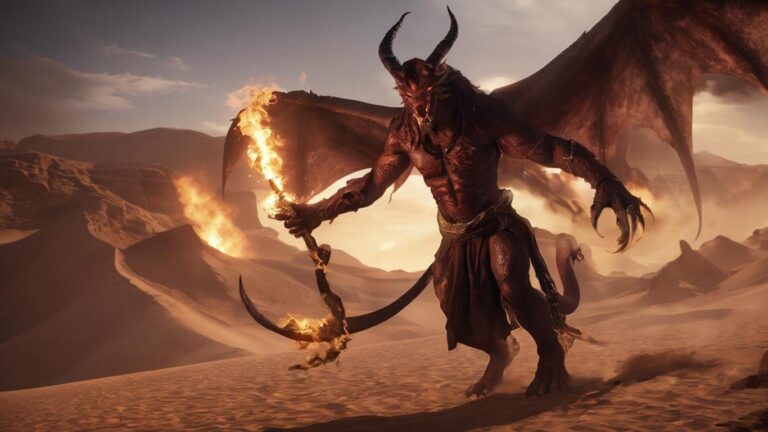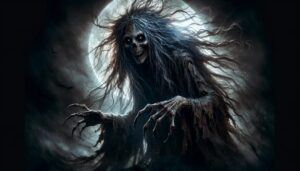Table of Contents
The term “Ifrit” originates from Arabic and Islamic mythology. Ifrits are supernatural beings, frequently portrayed as powerful and rebellious spirits composed of smoke and fire. In Islamic theology, they constitute one of the various classes of jinn, creatures created from smokeless fire. The Quran details the creation of jinn from smokeless fire, and they are acknowledged as beings with free will, capable of engaging in both good and evil actions.
The concept of Ifrits finds its ancient roots in pre-Islamic Arabian folklore, depicting them as potent and malevolent spirits. Over time, these narratives became interwoven with Islamic traditions, and Ifrits assumed a distinct role within Islamic cosmology.
Ifrits feature prominently in the collection of Middle Eastern folk tales known as “One Thousand and One Nights” (Arabian Nights). In these tales, Ifrits are frequently portrayed as cunning and formidable, possessing the ability to shape-shift and exhibiting great strength. They may be bound to serve humans through magical means or act independently, at times causing harm.
Overall, the origin of Ifrits lies in the rich tapestry of Arabian and Islamic mythology, blending ancient folklore with religious narratives to create a mystical and often fearsome class of supernatural entities.
Appearance
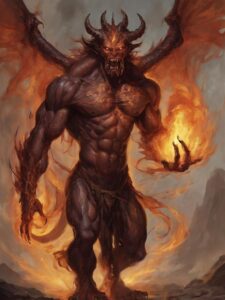
Ifrit is a mythical creature that appears in various Middle Eastern and Islamic traditions. The appearance of Ifrits can vary, as they are often described as powerful and malevolent spirits or demons. In Islamic folklore, Ifrits are said to be created from the smokeless flames of a desert fire. Here’s a general description of their appearance:
Fire Elemental: Ifrits are commonly associated with fire and are often depicted as beings of smoke and flames. Their bodies may be composed of the fiery substance, and they may have a glowing or flickering quality.
Humanoid Form: Ifrits are often described as having a humanoid shape, similar to humans but with some distinct features. They may have wings, horns, or other demonic attributes.
Glowing Eyes: Fiery or glowing eyes are a common characteristic of Ifrits. The eyes may emit a fierce and intimidating light, adding to their menacing appearance.
Monstrous Features: Depending on the cultural or artistic interpretation, Ifrits may have monstrous features such as sharp claws, fangs, or a fearsome visage. They are sometimes depicted as having a more demonic appearance.
Size and Strength: Ifrits are often described as powerful and formidable beings, possessing great strength and magical abilities. Their size can vary, but they are generally portrayed as larger and more imposing than humans.
Super powers
Fire Manipulation: Ifrits are closely associated with fire, and they are believed to have the ability to control and manipulate flames. This could involve summoning fire, creating infernos, or using fire as a weapon.
Shape-Shifting: Some traditions suggest that Ifrits have the ability to change their form, allowing them to take on different appearances. This shape-shifting ability can be used for deception or to move unnoticed among humans.
Superhuman Strength: Ifrits are often depicted as incredibly strong and powerful beings, surpassing the strength of humans. This strength can be used in both physical combat and to perform feats beyond the capabilities of mortals.
Flight: In some stories, Ifrits are said to have wings that enable them to fly. This ability adds to their supernatural nature and allows them to traverse great distances swiftly.
Magical Abilities: Ifrits are frequently associated with magic and are believed to possess various magical powers. This can include the ability to cast spells, create illusions, or manipulate reality in some way.
Immortality or Longevity: Ifrits are sometimes described as immortal or having an extended lifespan compared to humans. This immortality contributes to their otherworldly nature.
Myths

Creation of Jinn: In Islamic theology, it is believed that Allah created different beings, including angels, humans, and jinn. Jinn are created from smokeless fire, and they possess free will, allowing them to choose between good and evil.
Iblis and the Disobedience: The story of Iblis refusing to bow to Adam is mentioned in the Quran. According to the narrative, Allah created Adam and instructed the angels, including Iblis, to bow to Adam. While the angels complied, Iblis refused, considering himself superior to Adam. This act of disobedience led to Iblis being cast out of Allah’s favor.
Iblis as Shaytan: Iblis, after his disobedience, is often referred to as Shaytan in Islam. Shaytan is an Arabic term for a devil or a rebellious, malevolent force. Iblis is considered a tempter who tries to lead humans astray from the path of righteousness.
Differences from Satan in Other Traditions: While there are similarities between Iblis in Islam and Satan in other religious traditions, there are also significant differences. In Islam, Iblis is not considered a rival to Allah, and he will ultimately face judgment along with other disobedient beings. Additionally, Iblis is not an angel; angels in Islamic belief do not possess free will and always obey Allah’s commands.
Role in the Fall of Adam and Eve: Iblis is traditionally associated with tempting Adam and Eve, leading to their expulsion from paradise. However, Islamic interpretations may differ on the specifics of this narrative.
Is every Ifrit malevolent?
Although conventionally considered evil or malevolent beings, Ifrits can possess pure souls. Similar to humans, Ifrits have been granted free will and, as a result, can autonomously decide how they lead their lives. They may be believers or nonbelievers, and their nature can range from pure of heart to inherently evil.
Ifrits who embrace belief in Allah occasionally manifest in the homes of Muslims in the form of a snake. Consequently, believers are prohibited from dispatching them without first invoking the name of Allah at least three times as a warning to these jinn. If the snake persists in the home of the believer after mentioning the name of Allah three times, believers can reasonably assume that the snake is a devil, and they can eliminate the creature without hesitation.
Forms of the Ifrit
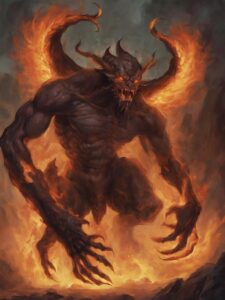
The Ifrit takes various forms. While they prefer manifesting in their formidable state, they possess the ability to assume other forms. In their natural form, an Ifrit emerges as a robust, smoke-like entity forged from fire. However, when adopting different guises, they can conceal themselves as animals or ordinary humans. According to certain legends, an Ifrit in human form may be perceived as individuals turned black by fire, leading to the belief that many Africans were considered Ifrit by those influenced by Arabic lore.
Renowned for their formidable power, Ifrits, as suggested by their name, are either exceptionally strong, rebellious, or both, evoking fear. In addition to their strength, they wield the same abilities as other jinn, enabling them to transform into nearly any desired shape and cast spells. Moreover, their immunity to mortal weapons renders their great power and might often insurmountable by human strength alone.
Can an Ifrit be Overpowered or Killed?
In various mythologies and folklore, whether one can overpower or kill an Ifrit depends on the specific narrative and the cultural or religious context within which the story unfolds. Portrayed as powerful and formidable beings, Ifrits present challenging adversaries due to their abilities. Nevertheless, there exist ways in which they can be dealt with or neutralized, and here are some common themes found in different traditions:
Supernatural Abilities: Ifrits are often depicted as possessing supernatural powers, such as control over fire, shape-shifting, and magical abilities. Overcoming an Ifrit may require knowledge of these powers and finding ways to counter or resist them.
Magical Measures: In some stories, specific rituals, spells, or magical artifacts are needed to control, banish, or defeat an Ifrit. Knowledge of these magical measures is typically held by skilled individuals or practitioners of magic.
Divine Intervention: In religious contexts, the intervention of a higher power, such as God or a divine being, may be necessary to overcome an Ifrit. This could involve prayers, invocations, or other acts of divine appeal.
Knowledge of Weaknesses: Like many mythical creatures, Ifrits may have weaknesses or vulnerabilities. Discovering and exploiting these weaknesses could be a key factor in overpowering or defeating them.
Human Virtue: In some stories, human virtue and righteousness play a role in overcoming malevolent entities like Ifrits. Acts of kindness, purity of heart, and adherence to moral principles may serve as protective factors.
Alternative Explanations for the Creation of Ifrits
Elemental Origins: Instead of being solely created from smokeless fire, Ifrits could be associated with other elemental forces, such as earth, air, or water. Each elemental origin could imbue them with distinct powers and characteristics.
Cursed Beings: Ifrits might be portrayed as beings cursed by a powerful force or deity, transforming them into malevolent entities. This curse could be a consequence of their own actions or rebellion against divine authority.
Interdimensional Beings: An alternative explanation could involve Ifrits as beings originating from a different dimension or realm, crossing over into the human world. This concept opens up possibilities for unique interdimensional dynamics and conflicts.
Experimentation or Creation by Other Entities: Instead of being directly created by Allah, Ifrits could be the result of experimentation or creation by other supernatural entities. This could introduce a complex web of relationships and power struggles among various mythical beings.
Evolved Spirits: Ifrits might be portrayed as spirits that have evolved or transformed over time due to certain conditions or circumstances. This evolution could be linked to their interactions with humans or other supernatural forces.
Guardians of Nature: Ifrits could be depicted as guardians of specific natural elements, such as deserts, forests, or mountains. Their creation might be tied to the need for protectors of these environments, with their powers aligned to the forces they are meant to safeguard.
Celestial Rebellion: An alternative storyline could involve Ifrits as celestial beings who rebelled against a higher order, leading to their expulsion or transformation into malevolent entities. This narrative could draw parallels with angelic rebellions found in other mythologies.
Symbolic Representations: Ifrits could be symbolic representations of natural forces, human emotions, or societal issues. In this interpretation, their creation may symbolize the emergence of certain challenges or struggles in the world.
Famous Ifrit
Iblis
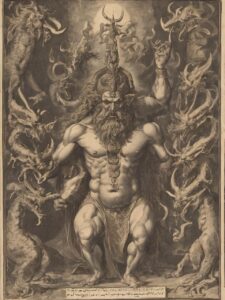
Iblis, the most famous among the ifrit people, displayed disobedience to Allah. Angered by Allah’s favoritism towards Adam and Eve, a new race he deemed inferior to his people, Iblis, an ifrit made of smokeless fire with greater power and strength than humans, looked down upon Allah’s creations of brittle clay with disdain.
Hamou Ukaiou
Hamou Ukaiou, an evil ifrit, is rumored to be wed to another jinn named Aicha Kandida. The couple shares a reputation for employing similar night hunting tactics, with Hamou focusing on preying on women and Aicha on men.
Known for his predatory actions, Hamou Ukaiou specifically targets women who travel alone at night, seeking opportunities to attack and devour them. His menacing presence instills fear, contributing to the reluctance of female travelers to venture alone during the night.
While most ifrit remain unaffected by human weapons, there is a belief that sharpening a knife on the ground may prompt Hamou Ukaiou to flee from his intended target.
The Three Wishes Myth
Despite ifrit being considered powerful and mighty creatures, there are believed to be several ways to gain power over them. The most common methods involve using magic or invoking Allah through prayer.
By utilizing magic, a person can harm or bind an ifrit to an object. Over time, this practice led to the development of the legend of the three wishes. According to this lore, encountering an item with an ifrit bound to it would grant the discoverer three wishes by rubbing or cleaning the object.
However, it’s crucial to note that even an enslaved ifrit remains incredibly sly and cunning. If an ifrit is bound against its will, it often manipulates the wording of its master’s wishes to undermine their intentions. Instead of fulfilling wishes in line with their master’s desires, they adhere strictly to the exact wording, allowing them to subtly resist and exact revenge against those who attempt to harness their power without consent.
Variations of the three wishes myth suggest that ifrit may trick individuals into making more than three wishes. Once a fourth wish is made, the previous three wishes become undone, enabling ifrit to take revenge on those who word their wishes precisely enough to resist manipulation.
While the three wishes myth gained popularity, it seems to be no more than a myth. Most stories regarding ifrit bound to items suggest that they only follow the wishes of the current possessor of their object and will only serve another if ownership is transferred to that person.
Other Jinn: Marid
The marid, among all the jinn, closely resemble the ifrit. Some speculate that these may be the same species of jinn due to the close meaning of the two names (marid is also another word for ‘rebellious’). Opinions vary regarding the relationship between these two creatures, although the prevailing view suggests that they are distinct races.
While ifrit are highly powerful, the marid are reputed to be the strongest of all the jinn. They prove challenging to control but possess significant knowledge, particularly in the realm of magic. Throughout history, marid have been known to offer assistance to kings and holy men.
Marid are characterized by their blue color and are believed to be spirits of the sea. The significance of their blue hue is thought to symbolize their exceptional intelligence and advanced age.
FAQ
What is the origin of the term "Ifrit"?
The term "Ifrit" has Arabic origins and is derived from the root 'afara,' which means to be obedient or to be well-behaved. However, Ifrits are commonly associated with rebellious and malevolent behavior.
Are Ifrits mentioned in religious texts?
Yes, Ifrits are mentioned in Islamic theology, particularly in the Quran. They are considered one of the creations of Allah, made from smokeless fire.
Do Ifrits have a specific appearance?
Ifrits are often depicted as powerful and cunning creatures. While they can take various forms, they are commonly associated with the image of a fiery being.
What role do Ifrits play in Islamic mythology?
Ifrits are known for their disobedience to Allah's commands. One notable story involves the Ifrit Iblis, who refused to bow to Adam and was subsequently expelled from paradise.
Can Ifrits be benevolent?
While Ifrits are often portrayed as malevolent, there are variations in folklore where some Ifrits may choose to follow the path of righteousness and embrace belief in Allah.
Are Ifrits believed to harm humans?
Yes, Ifrits are often associated with mischief and may harm humans. However, beliefs about their interactions with humans can vary across different cultures and interpretations.
How can one protect themselves from Ifrits?
Islamic traditions recommend seeking protection through regular prayers, recitation of specific verses from the Quran, and maintaining a strong connection with Allah.
Can Ifrits be summoned or controlled?
Islamic teachings strongly discourage attempting to summon or control Ifrits, as they are considered powerful entities beyond human control. Such actions are seen as disobedience to Allah.
Do Ifrits have a role in popular culture outside of religious texts?
Yes, Ifrits have often been featured in various forms of literature, art, and popular culture, sometimes deviating from their traditional Islamic portrayal to fit different narratives and interpretations.
